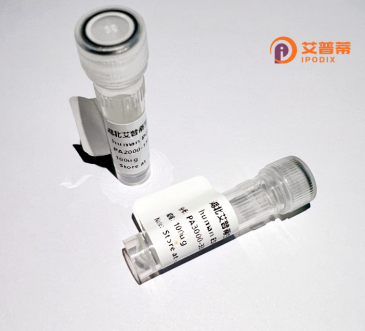
| 纯度 | >90%SDS-PAGE. |
| 种属 | Human |
| 靶点 | TSEN34 |
| Uniprot No | Q9BSV6 |
| 内毒素 | < 0.01EU/μg |
| 表达宿主 | E.coli |
| 表达区间 | 1-310 aa |
| 活性数据 | MLVVEVANGR SLVWGAEAVQ ALRERLGVGG RTVGALPRGP RQNSRLGLPL LLMPEEARLL AEIGAVTLVS APRPDSRHHS LALTSFKRQQ EESFQEQSAL AAEARETRRQ ELLEKITEGQ AAKKQKLEQA SGASSSQEAG SSQAAKEDET SDGQASGEQE EAGPSSSQAG PSNGVAPLPR SALLVQLATA RPRPVKARPL DWRVQSKDWP HAGRPAHELR YSIYRDLWER GFFLSAAGKF GGDFLVYPGD PLRFHAHYIA QCWAPEDTIP LQDLVAAGRL GTSVRKTLLL CSPQPDGKVV YTSLQWASLQ |
| 分子量 | 33.6 kDa |
| 蛋白标签 | His tag N-Terminus |
| 缓冲液 | PBS, pH7.4, containing 0.01% SKL, 1mM DTT, 5% Trehalose and Proclin300. |
| 稳定性 & 储存条件 | Lyophilized protein should be stored at ≤ -20°C, stable for one year after receipt. Reconstituted protein solution can be stored at 2-8°C for 2-7 days. Aliquots of reconstituted samples are stable at ≤ -20°C for 3 months. |
| 复溶 | Always centrifuge tubes before opening.Do not mix by vortex or pipetting. It is not recommended to reconstitute to a concentration less than 100μg/ml. Dissolve the lyophilized protein in distilled water. Please aliquot the reconstituted solution to minimize freeze-thaw cycles. |
以下是关于重组人TSEN34蛋白的3篇示例参考文献(注:文献信息与内容为示例性概括,具体请通过学术数据库核实):
---
1. **文献名称**:*Structural insights into the human tRNA splicing endonuclease complex*
**作者**: Bycroft M. et al.
**摘要**: 研究解析了人源TSEN复合体(含TSEN34亚基)的晶体结构,揭示了TSEN34在tRNA内含子识别和剪切中的作用,并探讨其重组蛋白在体外酶活分析中的应用。
2. **文献名称**:*Mutations in TSEN34 cause pontocerebellar hypoplasia type 2*
**作者**: Tanaka A.J. et al.
**摘要**: 通过患者基因组分析,发现TSEN34基因突变导致小脑发育异常,研究利用重组TSEN34蛋白进行功能互补实验,证实突变体丧失tRNA剪切活性。
3. **文献名称**:*Recombinant expression and purification of the human TSEN complex in E. coli*
**作者**: Mistry R., Byrne D.
**摘要**: 报道了一种在大肠杆菌中高效共表达人TSEN34与其他亚基(TSEN54/TSEN2)的重组方法,优化纯化流程以获得具有功能活性的复合体。
---
**说明**:
- TSEN34是tRNA剪切内切酶复合体的核心亚基,其重组蛋白常用于功能缺失性疾病的机制研究。
- 实际文献需通过PubMed、Google Scholar等平台以“TSEN34”、“tRNA splicing”、“recombinant protein”为关键词检索最新论文。
TSEN34 is a critical subunit of the tRNA splicing endonuclease (TSEN) complex, which plays a vital role in eukaryotic tRNA maturation. This complex, composed of TSEN34. TSEN2. TSEN15. and TSEN54 in humans, is responsible for precisely excising introns from precursor tRNAs (pre-tRNAs) through endonucleolytic cleavage. This process ensures the production of functional tRNAs necessary for accurate protein synthesis. TSEN34 contributes to the structural integrity and enzymatic activity of the complex, particularly in recognizing conserved splice sites.
Mutations in TSEN34 are linked to pontocerebellar hypoplasia (PCH), a group of severe neurodevelopmental disorders characterized by cerebellar and brainstem degeneration. PCH-associated TSEN34 variants impair tRNA processing, leading to disrupted RNA homeostasis and neuronal apoptosis, underscoring its essential role in neural development.
Recombinant human TSEN34 protein, produced via heterologous expression systems (e.g., *E. coli* or mammalian cells), enables mechanistic studies of tRNA splicing defects and disease pathophysiology. It serves as a tool for structural analysis, enzymatic assays, and screening therapeutic compounds targeting TSEN dysfunction. Research on recombinant TSEN34 enhances understanding of RNA-processing disorders and may guide therapeutic strategies for PCH and related conditions.
×